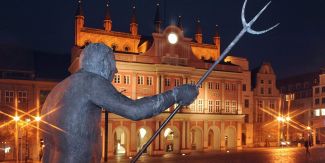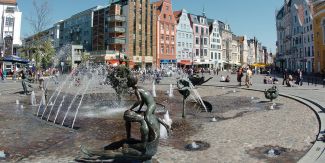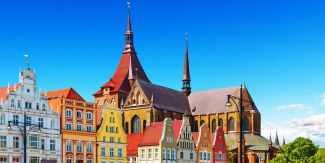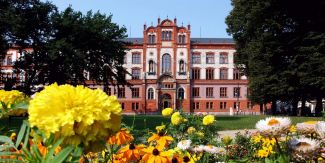
New Market
The New Market in the heart of the city is one of the oldest of Rostock’s squares. It is framed by the town hall, St. Marien Church and the beautiful gabled houses of various styles.
18055 Rostock, Germany
The port, shipyard and university city of Rostock has enjoyed a long and fascinating history. The city was founded more than 800 years ago. Rostock’s evolution into a thriving metropolis can be traced to the thriving trade in fish and beer, thanks to its location on the Baltic Sea. As a member of the Hanseatic league, it became one of the wealthiest cities in the Holy Roman Empire of the German nation. The influences of this period can still be seen in Rostock today: Many of the city’s walls, gates, bridges and market places near the harbour are very well preserved and offer a fascinating insight into how Rostock would have looked in the Middle Ages. Create your own picture!
A tour of Rostock’s Old Town offers countless sights to explore. Beginning with the city’s harbour, which was once the heart of the city. Goods were still handled here up until 1960, when the seaport opened in Warnemünde. Today, the harbour is a popular place for a leisurely stroll among tourists and locals alike. There is a varied selection of restaurants, shops, charming old stores and museum ships to explore. Trips around the harbour are also possible, providing an opportunity to get to know the city from a different perspective.
Like many large German cities, the city is made up of several parts, including Kritzmow, Hohe Düne, Torfbrücke and Nienhagen.
Starting from the B&B Hotel Rostock-Hafen, the Warnow extends in front of you, which can be reached in about 15 minutes on foot. From here, you have convenient connections to all parts of the city. Our friendly staff is available at reception from 06:30 to 22:00 to assist you. Our clean beds and modern rooms are perfect for restful nights.
Our hotel offer includes free Wi-Fi.
For shopping enthusiasts, we recommend the Hanseatic outlet, which is only about a 10-minute drive from our B&B Hotel Rostock-Hafen heading towards Broderstorf.
From the harbour, it is just a short walk to Rostock’s other must-see attractions. One of these is the Marienkirche church, which is best known for its astronomical clock. This internationally unique timepiece is located behind the church’s altar, and stands at a height of 11 metres. Dating from 1472, the clockwork still functions perfectly to this day, a technical masterpiece from an earlier era. A visit to the Neuen Markt market, close to the Marienkirche, is also highly recommended. This was the central goods shipment point in the Middle Ages, which is why the town hall is also nearby. The market place is also encircled by magnificent gabled houses, which stand testament to the wealth of their early inhabitants.
The B&B Hotel Rostock City-West is just a 15-minute walk from Rostock's old town. Our friendly staff will welcome you right on arrival and will be happy to answer any questions you may have. Whether you are a business traveler, a single traveler or a family — in our B&B hotel you have the option of choosing between a single room, double room or family room (subject to availability).
We look forward to welcoming you to Everyone's Bar when you arrive. Whether as a refreshment after a long journey or as a last little break before exploring the city. In our bar, we serve delicious cocktails, freshly tapped beer and crispy pizza.
Those with an interest in culture will find much to appeal to them in this Hanseatic city, from music to theatre and art. Rostock’s Volkstheater theatre stages various events throughout the year, from dance and music to orchestral and theatrical performances. For those who enjoy independent theatre, the ‘Hochschule für Musik und Theater’ (HMT) is a popular venue. Events are staged there regularly, including some that are even free of charge. Fans of modern and contemporary art will enjoy a visit to the Kunsthalle Rostock gallery. It is home to a collection of nationally and internationally famous artworks. Various special exhibitions are held regularly throughout the year.
The Rostock City Hall also offers various events every year and is one of the largest event locations in Rostock. Concerts, comedy events, magic shows and sports events take place in the town hall. As the calendar of events always has something to offer, visitors to Rostock can look forward to some unusual performances in the city hall.
Rostock is suitable for a variety of activities. This Hanseatic city is not only renowned for its medieval city harbour, but also for the Baltic beachfront in Warnemünde, the ideal place for a family excursion. The Baltic baths in Warnemünde are just a short distance away. Children can take part in an exciting activity programme, while you enjoy the white sand beach and relax on a traditional deck chair if the weather is nice. By the way: The beach chair was invented right here back in 1882. Thrill-seekers will find plenty of watersports to entertain them, from waterskiing to canoeing, sailing, surfing and wakeboarding.
Beautiful green areas can also be found in Rostock, especially by the water, while small stretches of forest and nature constantly spread out along the shore.
As a Hanseatic city that has thrived over many years on beer and fish, the culinary arts have not been neglected in Rostock. There is something to suit every palate and every budget. The ‘Hopfenkeller’ restaurant in Rostock’s Old Town offers traditional, home-style cooking in a rustic atmosphere, while ‘Newport Fisch’ serves freshly-caught fish from the Warnemünder marina, with a view over the Baltic Sea. For a pub tour, head to the popular student quarter ‘Kröpeliner-Tor-Vorstadt’ (KTV for short), where you’ll find many bars, restaurants and cafes. The quaint ‘Pirat’ pub is well worth a visit. It has been lovingly decorated to resemble a pirate ship.
As most of the main attractions are located in Rostock’s Old Town, these can all be easily reached on foot. Other attractions which are slightly further afield, such as the Rostock Zoo or Warnemünde beach, can be easily reached by public transport. With the Verkehrsverbund Warnow (VVW) network, you can use the same ticket to travel on trains, trams, busses and ferries through Rostock and the surrounding district. A regular day ticket for Rostock costs €6, a weekly ticket costs around €20. If you only intend to spend one or two days in the Hanseatic city, you can use the RostockCARD. This can be purchased for €12 (24hrs) or €17 (48hrs) and covers travel in the Rostock area, as well as discounts to various attractions in and around Rostock.
Whether you are travelling by car, bus, train or ferry - Rostock can be easily reached by various routes. The city even has its own airport (Rostock-Laage), located 30km from the city centre. There are direct flights from Vienna, Munich, Antalya and Mallorca.

The New Market in the heart of the city is one of the oldest of Rostock’s squares. It is framed by the town hall, St. Marien Church and the beautiful gabled houses of various styles.

The fountain on University Square was built at the beginning of the 1980s by the Rostock sculptors, Jo Jastram and Reinhard Dietrich. In the background stands the main building of the University.

The Astronomical Clock in St. Marien’s was built in the year 1472, and is known worldwide for being the only medieval-style one of its kind. Next to the hour, you can see an extensive calendar and astronomical data. The apostles appear every day at 12.00 noon.

The square in the middle of the city brings together the Lebensfreude Fountain, the university’s main buildings and the Blücher Memorial, as well as the five-gabled, slab house. The five-gabled house was built in the 1980s and houses a glockenspiel. Every Saturday at 12.00 noon, visitors and locals can listen to the sound of the 32 fine-tuned bells.

The stone gate was built in the style of the Dutch brick renaissance in the middle of the 16th century. The side of the stone gate facing the city is more beautifully decorated and has an inscription: “Sit intra te concordia et publica felicitas”” (“within your walls there is harmony and well-being”). Above the gate, you can see the seals of the era. The Estates House right next door was built around 1890 in the historicism style. The magnificent brick building was the seat of the parliament of the influential Mecklenburg country estates, to which the nobility and cities belonged. Today it acts as the seat of the Higher Regional Court.